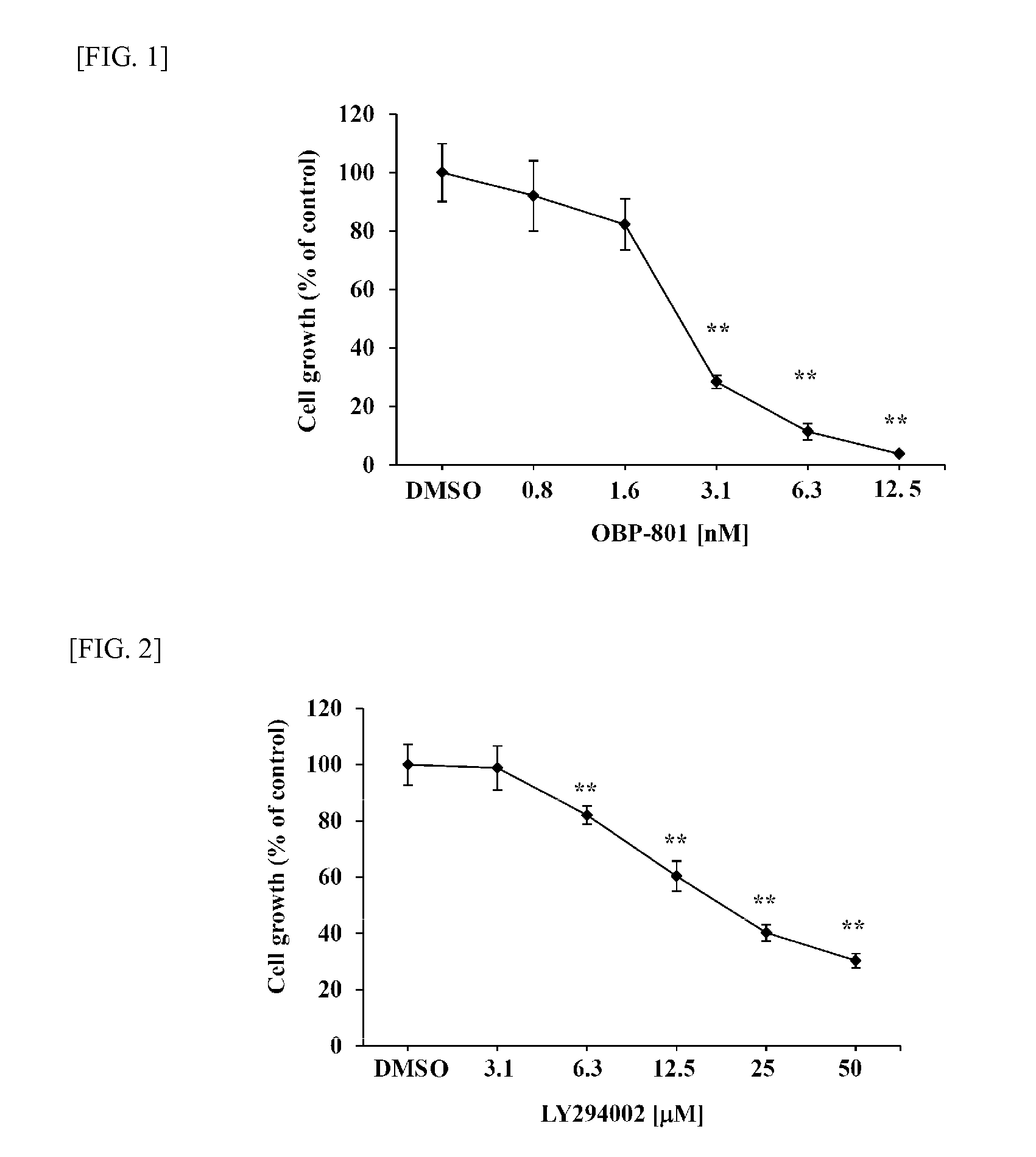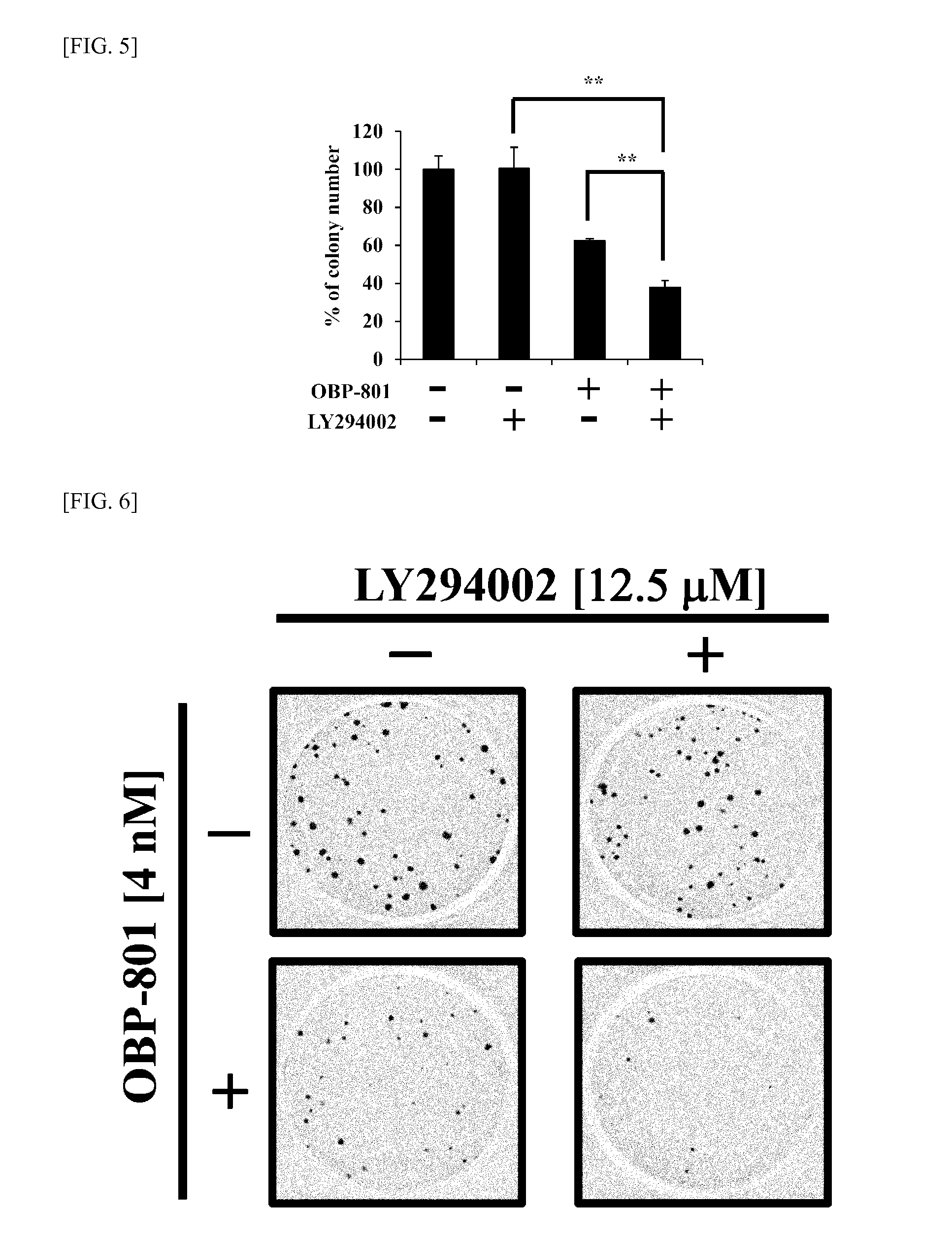Molecularly targeted combination drug for tumor treatment and prevention
a combination drug and molecular targeting technology, applied in the field of molecular targeting combination drugs for tumor treatment and prevention, can solve the problems of insufficient treatment of malignant tumors such as cancer or the like, inability to adequately treat malignant tumors, and no report of hdac inhibitors for cancer treatment or other such malignant tumors, and achieve the effect of increasing the accumulation of intracellular reactive oxygen species
- Summary
- Abstract
- Description
- Claims
- Application Information
AI Technical Summary
Benefits of technology
Problems solved by technology
Method used
Image
Examples
working examples
[0139]In the context of tumor treatment and prevention, it was demonstrated that there was marked tumor therapeutic / preventive effect as a result of combined use of OBP-801 and PI3K inhibitor. In the present working example, human endometrial cancer, human renal cell carcinoma, human lymphoma, and human breast cancer were employed as examples of tumors subject to treatment by the present invention; and LY294002, BKM120, GDC-0941, BEZ235, BYL719, and CH5132799, which are of respectively different structure and so forth, were employed as examples of PI3K inhibitor used in combination with OBP-801.
Materials and Methods
1. Cell Culture
[0140]HEC-1-A cells derived from the human type 2 endometrial carcinoma cell line were cultured under conditions of 37° C. and 5% CO2 in RPMI medium to which 10% FBS had been added. Ishikawa human endometrial carcinoma cells were cultured under conditions of 37° C. and 5% CO2 in DMEM medium to which 10% FBS had been added. Human renal cell carcinoma cell li...
working example 2
Synergistic Enhancement of Inhibitory Effect on Tumor Cell Colony Formation Due to Treatment in which the PI3K Inhibitor LY294002 is Used in Combination with OBP-801
[0152]A colony formation assay employing HEC-1-A cells was carried out to investigate the growth-inhibiting effect of combined treatment with OBP-801 and the PI3K inhibitor LY294002 on tumor cells within tumor tissue. As a result, no reduction in the number of colonies formed was observed even at a concentration as high as 12.5 μM when treatment was carried out using LY294002 alone, but the number of colonies formed was reduced to 60% when treatment was carried out using OBP-801 alone at a concentration of 4 nM.
[0153]In addition, whereas under the foregoing conditions the PI3K inhibitor LY294002 did not cause decrease in the number of colonies formed when used alone as described above, it was most interestingly discovered that when LY294002 was used in combination with OBP-801 there was indication of an effect whereby in...
working example 3
Synergistic Tumor Cell Apoptosis Induction Effect Due to Combined Treatment with OBP-801 and the PI3K Inhibitor LY294002
[0154]Flow cytometric analysis employing HEC-1-A cells was carried out to investigate whether OBP-801 and the PI3K inhibitor LY294002 had any effect on tumor cell cycle progression. Treatment was carried out using OBP-801 at a concentration of 4 nM, and LY294002 at a concentration of 12.5 μM. As a result, OBP-801 used alone caused G2 / M-phase arrest, and LY294002 used alone caused G1-phase arrest, after 24 hours to 72 hours of treatment (FIG. 8, FIG. 10, and FIG. 12).
[0155]It was however interestingly discovered that OBP-801 and the PI3K inhibitor LY294002 when used in combination caused marked occurrence of induction of apoptosis in HEC-1-A cells after 48 hours to 72 hours of treatment (FIG. 11 and FIG. 13). Moreover, it was determined that combination indices as a result of the foregoing combined treatment were less than 1.0, indicating that the rate of induction ...
PUM
| Property | Measurement | Unit |
|---|---|---|
| volume | aaaaa | aaaaa |
| drug resistance | aaaaa | aaaaa |
| frequency | aaaaa | aaaaa |
Abstract
Description
Claims
Application Information
 Login to View More
Login to View More - R&D
- Intellectual Property
- Life Sciences
- Materials
- Tech Scout
- Unparalleled Data Quality
- Higher Quality Content
- 60% Fewer Hallucinations
Browse by: Latest US Patents, China's latest patents, Technical Efficacy Thesaurus, Application Domain, Technology Topic, Popular Technical Reports.
© 2025 PatSnap. All rights reserved.Legal|Privacy policy|Modern Slavery Act Transparency Statement|Sitemap|About US| Contact US: help@patsnap.com



